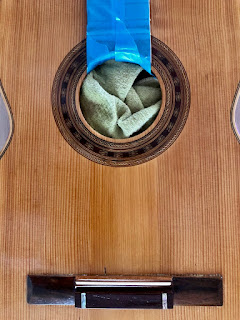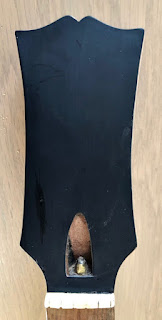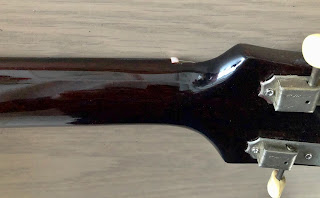Een Juan Estruch gitaar uit de jaren zestig, althans af
te leiden uit het label in weer goede, bespeelbare staat.
SOLD.
Over de toets kan ik niet heel duidelijk zijn: Wellicht
toch geen ebben maar palissander. Een waaiervormige
bebalking van 5 stuks. Keurig houtwerk in de klank-
kast en een mooi gemodelleerde Spaanse hak aan
de binnenkant. Massief fichten bovenblad.
Een wat rijker versierd model met goudkleurige
stemmechanieken en mooie randinleg zoals je dat
ook bij de Concerto modellen tegenkomt. Mahonie-
houten klankkast en een prima geluid dat nauwe-
lijks hoeft onder te doen voor de Concerto reeks.
Fraai uitgevoerde rozet. En het fretwerk is helemaal
nagelopen, rond gemaakt en opnieuw gepolijst.
Het Juan Estruch Label zoals je dat ook tegenkomt
op de site van Jedistar waar dit label gedateerd wordt
zijnde van de zestiger / zeventiger jaren. Geen
modelnummer wordt hierop vermeld..
Dit label is vrij lang in gebruik geweest bij Juan Estruch
De periode waarin het werd gebruikt strekt zich echter uit
van plm. 1930 tot 1960.
Nieuw en netjes kambeentje, uiteraard NIET
van plastic. De topkam meet 53 mm breed.
Goed werkende stemmechanieken. Uit de tijd van
de bouw van dit instrument. Vaak zaten deze me-
chanieken maar dan in chroom uitgevoerd op de
studentengitaartjes van Spaanse bouwers.
Prettige speelactie en dat in combinatie met een men-
suur van 645 mm. Geschikt voor kleinere handen.
Wel wat gebruikerssporen maar nergens scheuren
Vreemde optie voor de kop om daar een
andere kleur houtsoort voor te gebruiken. Dat
hals en kop uit een stuk zou moeten zijn gemaakt
is natuurlijk een fabeltje maar vaak is het mooi
weggewerkt bij de duurdere instrumenten.
De meerkleurige randinleg zoals je dat ook tegenkomt
bij de bekendere Concerto reeks. Deze gitaar kom je
ook tegen op de site van Reverb waar er 350 Dollar
voor gevraagd wordt en dan krijg je er gratis wat
scheuren in de klankkast bij!
Netjes gemodelleerd nieuw kambeentje en frets
zonder enige slijtage sporen.
Juan Estruch ( from 1930 onwards )
A fairly old Juan Estruch but with the round label the
company used from 1920 until 1954. Adress: Calle Ancha 30
Barcelona (Source: Romanillos). In the mid twenties of the last
century Juan Estruch Sastre imported wood and materials
(from 1919) and guitars (1923-25) from Telesforo Julve
and by seeing the typical bridge inlays this could have
been one of them. Even the carving of the bridge is identical
to the TJ bridges. This is more than a coincidence!
It is obvious the guitar has "lived" and will be brought back
to live though there is a lot left to be done. In fact the Rosette
shows us a nice wooden inlay so no concentric circles only!
Funnily enough I found the exact same rosette on a Telesforo
Julve guitar and with the same executed extended fingerboard -
no coincidence of course! This guitar has a three piece
soundboard as can be found more often on TJ's.
So the rosette here above left comes from a Telesforo Julve
guitar and one might compare this with another more elaborate
built up rosette on a Salvador Ibanez e Hijos guitar also in this
Blog. I've added it here as the red and white inlays only differ a
bit from the rosette of this Salvador Ibanez guitar. TJ took over
the Ibanez workshop and possibly some workers there. The
rosette at the right however comes from an Audex labelled
guitar but made by Jose Roca and similarities with this
rosette are also there....
Though the label here above says Juan Estruch we have to conclude
that this guitar has been made in the Jose Roca factories. The rosette
itself in fact was already a confirmation around this subject. By
looking at the period this label was used one might conclude that
this instrument was made by the granddaughter of Andres Marin
who had her business before Jose Roca took over.
In fact the rosette was already a bit of a confirmation that
the Valencian workshops exported a lot of their guitars to
other cities and abroad. The two abalone inlays were just
a funny addition that came to the clients' mind on this
S. Ibanez e Hijos labelled guitar from around 1920.
Another remarkable move was the narrow 5 fan bracing
in this guitar as is there in the Juan Estruch guitar
from about 1925 decribed here.
The back and sides are making this guitar even more
remarkable as one can conclude the wood to be walnut
but of a higher quality. A cedar neck with a fingerboard
of a strange reddish color but dense enough to do a good
job! The same wood I have found on my Telesforo Julve
from the fifties. Soundboard is spruce, fairly wide grained.
The soundboard is supported by a 5 fan bracing but all
quite close to each other. The inner heel shows a higher
standard than was usual in the Telesforo Julve guitars.
A "Torres" kind of head form, Estruch later used for the
Concerto series. Wether if the tuners are original I really
do not know. The headstock is nicknamed: "shouldered".
But in fact a bit crudely shaped so I will make some
corrections to it though I know: not original anymore.
The "original" shape has been damaged on the back
so that's the reason I will reshape it.
I decided to proceed the restoration from this guitar as
the sound is surprisingly good and complete. However
the markings at several places on the back of the neck
and the placing of a new fingerboard urged me to
relaquer the neck and head. As the head was not treated
that well I had to remove some damages and decided
to redress the head as a whole to a more Torres-like
approach. Thoroughly cleaning of old tuners in fact
is a must. Here the final result can be seen.
The typical "Valencian" way of constructing a heel.
The heel is rounded and that would date the guitar
between 1909 and 1945. ( If this is a Telesforo Julve.)
Please note that Marcelo Barbero also used this way
of constructing a heel.
The tuners from which it is questionable if they were
there at the birth of this guitar. So, what to do first:
As the transverse bar under the fingerboard came off
the guitar already had a bad playing action but even
after repairing that it will not solve the whole problem.
The back is partly loose so the invitation lies there:
"Remove me please" then it will be possible to lift the
soundboard a bit with a reglued brace. A neck reset is
easy when the back has been removed but a Spanish
heel is allways a bit of a problem. These tuners have
been spot as well on a 1920 / 1930 Juan Estruch so
it could have been possible that some guitars were
assembled in Barcelona as the other Estruch was a
really high end model of the company.
A remark should be made here about the way of mounting
the well known button / worm gear invention as that hasn't
been always the same! Roughly between 1910 and 1920
the way the machine heads were mounted changed. Here
above presented is the way most companies are doing it
nowadays but before 1910 the worm gear was mounted
closest to the guitar body and the cylinder or capstan
followed. The same can be concluded when looking at
older mandolins.
On this picture the rather strange 5 fan bracing is visible.
Strange in a sense that the 5 bars have been placed quite
close to each other. Another remarkable feature is the
placing of 6 clamps in the lower bout in order to
strengthen the two seams of the 3 piece soundboard.
The brace left most likely got loose and as a result the
fingerboard "moved' under the string tension as can be
seen in the sound hole. Obviously the soundboard as
a whole shows a sag at that point as a result.
Maybe not that interesting but for two reasons I've included
this picture. It shows an end block which is quite similar to
those that can be found in the Telesforo Julve guitars and
besides that 6 rather crudely shaped clamps in order to
strengthen the two seams of the 3 piece soundboard. The
same feature I found in my fifties Telesforo Julve that
has a 3 piece soundboard as well. It is even questionable
wether if the builder did this on purpose as there are also
three piece soundboards on some Antonio de Torres guitars.
Exactly the same shaped end block in my fifties TJ guitar.
It would have been logically that with the loosening of
the now visible transverse brace the soundboard cracked
along the fingerboard as a result of string pressure but
after having removed the fingerboard it became obvious
that the so called cracks in fact are seams of the middle
part of the soundboard. There was no other way to make
a proper correction of the "moved" soundboard piece
under the old fingerboard without removing it.
Now the bit deformed whole neck setting as a result
of string tension is able to "come back" to its'
original position. Another problem remains the scale
of the original fingerboard: 650 mm as the distance
between the nut and 12th fret is 325 mm but from
the 12th fret to the bridge bone 320 mm (!) Partly due
to the deformation of the whole neck area but also a
not properly glued bridge distance! I have an ebony
fingerboard already slotted for a 640 mm scale.
I can place that instead of the original and still have
a 2 mm compensation which is normal nowadays.
And remember: In former times there was not taken
care for a compensation as string height was usually
much lower!
I will close the seam on the right properly and make an
insert left as that part will be covered by the new fingerboard.
Securely flattening out this area and comparing
it with the rest of the neck is very important now
as I decided to place the frets before gluing the
fingerboard. The pictured area is too vulnerable
for hammering in frets even with a decent support.
I have a 19 fret fingerboard now which is very suitable for
the more demanding musical pieces. As I explained earlier
the scale is now 640 mm with a compensation from the
12th fret to the bridgebone of 2 mm.
As the earlier fingerboard had a scale of 650 mm I had
to make a solution for the top nut. If you take a closer
look at the first Juan Estruch presented in this blog you
can conclude I used their own method to solve this
problem. Just a small piece of ebony placed above
the top nut so the new situation has a natural look
regarding proportions.
The twelfth fret is a fraction more reachable now but
that can play an important role in some musical pieces.
Next step is to glue the back in place. I think it has to be
shortened by around 2 / 3 mm for a proper neck reset
and that won't be a big problem.
The back has been placed and glued. The top has been
treated with a greyish color remover for bare wood and
that had a significant effect on the color of the top. The
sound after putting the strings on is typical for the Valencia
guitars but compared to my fifties Telesforo Julve it
has more power in the higher notes. The guitar is not
"shining" (brightness of the higher notes) the way my
Jose Ramirez 1945 does but that can have two causes:
The top still has to be relaquered and the guitar needs
to be "played in" again! The soundbox own frequency
lies on the note G which means 98 Herz.
Not yet the "final" result as the binding on the back has
to be redone partly: Gluing on an existing back and giving
the instrument a slight neck reset at the same time means
an inevitable unevenness at some spots. But the top is
relaquered now. Most of the time I polish the varnish
after about a year as only then you can get the amount
of brilliance in the lacquer you want because the lacquer
has to be hardened out. I used an Alkyd lacquer that
indeed adds to the brightness of the higher notes and
can be removed quite easily if there is a need to.
The relacquered back. And the sides have been done as
well as the old varnish gave the wood a more yellowish
appearance and that wouldn't combine with the varnish
on the back. It is a nice clear lacquer.
The result makes it obvious that walnut has a beauty
of its' own. These quality of walnut is simply different
from the later Spanish study guitars of the sixties and
seventies. The binding has been done by Bram Waque.
He did a nice job as well.
Maybe I will come up with an added strip between the
outer heel and the soundbox as that has been a bit crudely
done in the past.
The back of the guitar in combination with the rest.
In fact there were still two problems: The bridge was constructed
quite heavy and too high for a good playing action. Apart from that
the holes for the strings in the tieblock were placed too high.
As a result the strings didn't make a proper angle over the bridge
bone and were still too far away from the fingerboard.
As the fingerboard has been replaced with an ebony one I decided
to make an ebony bridge as well though less high as the original
one as the weight of a bridge has a negative influence on the
sound of an instrument. The Telesforo Julve strips are there!
It is a very nice playable and sounding instrument now with
a bit of a narrower neck suitable for some pieces.










































































